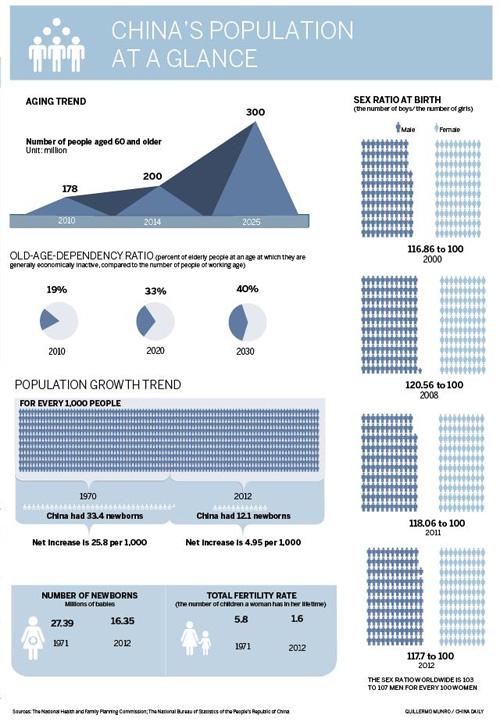
"Some were concerned that granting couples two children would see the situation get out of control," said Feng Caishan, then deputy head of Longhua township.

The pilot program stated women could not marry until they were 23 and men 25, and women could have the first child no younger than 24 and the second no younger than 30.
Family planning officials said allowing couples two children has made their work easier, despite there being more procedures.
To ensure the program had the desired effect, women must have contraceptive coils fitted after their first child and must be sterilized after their second.
"We had a lot more work to do, as we had to convince people to have operations after the birth of each child," Wang said. "But importantly the policy is workable because people are willing to cooperate."
In 2007, the county further loosened the birth policies and women could have their second baby no later than 28 years old.
"From the experience in Yicheng we can tell that when the policy goes against the will of people, the people will oppose it," said Feng Caishan, who became director of family planning for the county in 1990 and retired in 2002. "The policy should take the statistics into account, and people's feelings," he added.
Changing attitudes
Looking at the figures, the pilot was a success in effectively controlling population growth. Yicheng accounted for 1 percent of the population in Shanxi in 1982, but just 0.87 percent in 2010.
Meanwhile, in many neighboring counties, the family planning policy has faced a backlash. Some couples are even giving birth to three or four children, according to an official with the Yicheng Family Planning Association who spoke on condition of anonymity. The China Family Planning Association is the largest nongovernmental network active in reproductive health, family planning and HIV/AIDSprevention and care.
Despite being given the chance to have two children, more than 10,000 rural families in Yicheng have chosen to waive the right.
The number of residents in Chengde grew by 3.42 percent over that period, lower than the national growth rate of 5.84 percent.
In Enshi, the population decreased by 12 percent, as a result of the outflow of migrant workers, a study by demographer Yi Fuxian showed.
The population of Jiuquan, which implemented the policy in 1984, grew higher than the national average to 11.8 percent between 2000 and 2010, as the city's sixth population census showed.
According to Yi's study, the two-child policy in those areas improved the fertility rate, which measures the average number of children a woman gives birth to in her lifetime.
"In 2000 the rate in Chengde was 1.36, higher than the 1.29 for Hebei. In Enshi, the figure in 2000 was 1.36, higher than the 1.01 for Hubei," he told Caixin Magazine.
His study also found the policy was able to significantly balance the gender ratio.
In 2010, the ratio for children aged 1 to 4 was 110 boys for every 100 girls in Enshi, lower than that of Hubei province for that year, which was 124 boys for every 100 girls.
The ratio for ages 1 to 4 in Chengde and Jiuquan in 2010 — 114 boys for every 100 girls — was also significantly lower than that of provincial areas, Yi said.
One of the major problems brought about by the one-child policy is the imbalance of sex ratio at birth, as the 2010 national census showed China has a 118 boys born to every 100 girls.
However, Yi warned that the two-child policy could not provide a fundamental solution to the imbalance in sex ratio even though the chances of selective abortion would be reduced greatly.
"If couples were only allowed to have one child, half of all families would give birth to boys. If they were allowed to have two, three quarters of families would get at least one boy," he said. "There would be much less motivation for selective abortion.
"Compared with the one-child policy, allowing couples to have two children would reduce the sex ratio at birth. However, there is still the problem of an imbalance in sex ratio, as the experiment indicated.
Copyright ©1999-2018
Chinanews.com. All rights reserved.
Reproduction in whole or in part without permission is prohibited.